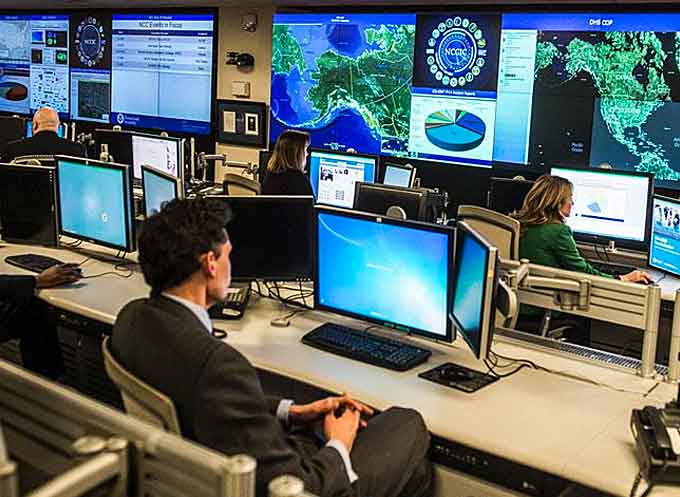On November 16, 2018, President Trump signed into law the Cybersecurity and Infrastructure Security Agency Act of 2018 which elevates the mission of the former National Protection and Programs Directorate (NPPD) within DHS, and establishes the Cybersecurity and Infrastructure Security Agency (CISA).
CISA leads the national effort to defend critical infrastructure against the threats of today, while working with partners across all levels of government and in the private sector to secure against the evolving risks of tomorrow.
The name CISA brings recognition to the work being done, improving its ability to engage with partners and stakeholders, and recruit top cybersecurity talent.
(U.S. President Donald Trump signed legislation Friday that will create a new cybersecurity and infrastructure agency within the Department of Homeland Security (DHS). The president held a signing ceremony for the Cybersecurity and Infrastructure Security Agency Act, which creates the Cybersecurity and Infrastructure Security Agency (CISA). The administration says this new agency will serve as the focal point for defending civilian and federal networks to protect critical infrastructure including the nation’s election security. Courtesy of AP and YouTube. Posted on Nov 21, 2018.)
What Does CISA Do?
CISA is responsible for protecting the Nation’s critical infrastructure from physical and cyber threats, and requires effective coordination and collaboration among a broad spectrum of government and private sector organizations.
Comprehensive Cyber Protection
CISA’s National Cybersecurity and Communications Integration Center (NCCIC) provides 24×7 cyber situational awareness, analysis, incident response and cyber defense capabilities to the Federal government; state, local, tribal and territorial governments; the private sector and international partners.

CISA provides cybersecurity tools, incident response services and assessment capabilities to safeguard the networks that support the essential operations of federal civilian departments and agencies.
Infrastructure Resilience
CISA coordinates security and resilience efforts using trusted partnerships across the private and public sectors, and delivers training, technical assistance, and assessments to federal stakeholders as well as to infrastructure owners and operators nationwide.
CISA provides consolidated all-hazards risk analysis for U.S. critical infrastructure through the National Risk Management Center.
Emergency Communications
CISA enhances public safety interoperable communications at all levels of government, providing training, coordination, tools and guidance to help partners across the country develop their emergency communications capabilities.
Working with stakeholders across the country, CISA conducts extensive, nationwide outreach to support and promote the ability of emergency response providers and relevant government officials to continue to communicate in the event of natural disasters, acts of terrorism, and other man-made disasters.
“The CISA Act elevates the cybersecurity mission within DHS and streamlines our operations to better secure the Nation’s critical infrastructure and cyber platforms,” according to Christopher Krebs, Director of Cybersecurity and Infrastructure Security Agency (CISA) in a statement.
(Undersecretary of Homeland Security for the National Protection and Programs Directorate Christopher Krebs discusses why we should care about disinformation, and how the Department of Homeland Security is working to secure future US elections. Courtesy of Disinfo Portal and YouTube. Posted on Oct 30, 2018.)
“CISA continues NPPD’s mission of leading the national effort to improve critical infrastructure security, coordinating the protection of the Federal Government’s networks and physical infrastructure, and helping entities in the public and private sectors manage risk,” continued Krebs.
“Our mantra moving forward is “Defend Today, Secure Tomorrow”.”
“We appreciate your strong partnership and support in executing our shared cyber and infrastructure security mission.”
“Becoming CISA represents real progress in the national effort to improve our collective efforts in cybersecurity and it improves our ability to engage with you, our stakeholders.”
“We look forward to working with you as we transform NPPD into CISA.”
(Learn More. See behind the scenes at the DHS cyber center following disclosure that over 143 million Americans were victims of an Equifax cyber breach. Courtesy of Fox News and YouTube. Posted on Sep 8, 2017.)
See the NPPD Organizational Chart as of October 2018 at https://www.dhs.gov/sites/default/files/publications/NPPD_ORG%20CHARTS_10102018_508.pdf
Organizational Changes Related to the CISA Act
The CISA Act establishes three divisions in the new agency: Cybersecurity, Infrastructure Security and Emergency Communications.
- The Act transfers the Office of Biometrics Identity Management (OBIM) to DHS’s Management Directorate.
- Placement within the DHS Headquarters supports expanded collaboration and ensures OBIM’s capabilities are available across the DHS enterprise and the interagency.
- The bill provides the Secretary of Homeland Security the flexibility to determine an alignment of the Federal Protective Service (FPS) that best supports its critical role of protecting federal employees and securing federal facilities across the nation and territories.

The Federal Protective Service (FPS), a 2018 ‘ASTORS’ Award Winner for Best Government Identification Management Solution, is the uniformed security police division of the United States Department of Homeland Security and is charged with protecting federal facilities, their occupants, and visitors by providing superior law enforcement and protective security services, and by leveraging the agency’s access to the intelligence and information resources of DHS’s network of federal, state, local, tribal, territorial, and private sector partners.
(See a brief overview of the Federal Protective Service (FPS). Courtesy of Basic Briefs and YouTube. Posted in May 2016.)
Federal Protective Service (FPS) Operations include, but are not limited to Explosive Canine Detection Teams, Hazardous Response Teams, Mobile Command Vehicles, Operation Shield and Protective Investigation Teams.
Explosive Canine Detection Teams
Federal Protective Service Explosive Detection Canine Teams include a highly trained detection dog and a law enforcement handler.
These teams conduct searches for a variety of explosive materials near building exteriors, parking lots, office areas, vehicles, packages, and people in and around federal facilities.
Hazardous Response Team
The Federal Protective Service responds to credible chemical, biological, radiological, nuclear and energetic materials (CBRNE) threats or incidents.

The CBRNE Program provides support to incident investigations, threat assessments, emergency operations, and provides evacuation support, mutual aid, and training assistance.
Mobile Command Vehicles
Federal Protective Service mobile command vehicles are deployed to enhance or reestablish communication and coordination during emergency incidents and special security events nationwide.
These assets leverage satellite and internet access, as well as interoperable radios and video capabilities to enhance communication between FPS assets and other federal and local response and support assets.
Operation Shield
Operation Shield is an ongoing program created to increase the visual presence of law enforcement at FPS-protected facilities to deter terrorist or criminal activity.
Protective Investigations Programs

The Protective Investigations Program (PIP) prevents targeted violence against persons and facilities under the protection of FPS.
The three key functions of the program are:
- Identifying those that might pose a threat
- Investigating and assessing those individuals, and
- Implementing a mitigation strategy designed to prevent an attack
Utilizing a behavior-based methodology, FPS special agents seek to identify not only those individuals who communicate threats, but also those that communicate in other inappropriate ways.
These investigations are often lengthy in nature and focused more on mitigation of the threat as opposed to prosecution.
Protective investigations require a unique set of investigative strategies that often times vary from other types of prosecutable offenses.

DHS Federal Protective Service
-
Platinum ‘ASTORS’ Award Winner
-
Best Government Identification Management Solution
-
Modified Infrastructure Survey Tool (MIST)
-
In collaboration with Argonne National Laboratory
The Annual ‘ASTORS’ Awards Program is specifically designed to honor distinguished government and vendor solutions that deliver enhanced value, benefit and intelligence to end users in a variety of government, homeland security and public safety vertical markets.
“‘ASTORS’ nominations are evaluated on their technical innovation, interoperability, specific impact within the category, overall impact to the industry, relatability to other industry technologies, and application feasibility outside of the industry,” according to Tammy Waitt, co-founder and editorial director of American Security Today.

The 2018 ‘ASTORS’ Awards Program drew an overwhelming response from industry leaders with a record high number of corporate and government nominations received, as well as record breaking ‘ASTORS’ Presentation Luncheon Attendees, with top firms trying to register for the exclusive high – end luncheon and networking opportunity – right up to the event kickoff on Wednesday afternoon, at the ISC East registration!
Over 130 distinguished guests representing National, State and Local Governments, and Industry Leading Corporate Firms, gathered from across North America, Europe and the Middle East to be honored among their peers in their respective fields which included:
- The Department of Homeland Security Federal Protective Service (FPS)
- Argonne National Laboratory
- The Department of Homeland Security
- The Department of Justice
- The Security Exchange Commission Office of Personnel Management
- U.S. Customs and Border Protection
- Viasat, Hanwha Techwin, Lenel, Konica Minolta Business Solutions, Verint, Canon U.S.A., BriefCam, Pivot3, Milestone Systems, Allied Universal, Ameristar Perimeter Security and More!
The Annual ‘ASTORS’ Awards is the preeminent U.S. Homeland Security Awards Program highlighting the most cutting-edge and forward-thinking security solutions coming onto the market today, to ensure our readers have the information they need to stay ahead of the competition, and keep our Nation safe – one facility, street, and city at a time.
The 2018 ‘ASTORS’ Homeland Security Awards Program was Proudly Sponsored by ATI Systems, Attivo Networks, Automatic Systems, Desktop Alert, and Royal Holdings Technologies.
Learn More…
DHS Federal Protective Service in 2018 ‘ASTORS’ Awards (Multi-Video)



















